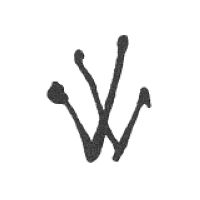
Image 011250-01/02-01
Used between 1764 and 1787.
In the year 1761 Johann Wolfgang Hamann from the city of Katzhütte applied for a porcelain production license in Schwarzburg-Rudolstadt, but only three days earlier an exclusive license had been issued for Heinrich Macheleid from Sitzendorf and so the application by Hamann was turned down. However, Hamann was not willing to give in easily and continued experiments with different mixtures and a year later he was able to produce hard paste porcelain at his home in Katzhütte.
Hamann actually was the official inspector for the ironworks in the area and had been planning to open a porcelain production factory together with his son Ferdinand Friedrich Hamann, but after his success in creating hard paste porcelain his son was able to convince the two cousins Johann Gottfried Greiner and Johann Gotthelf Greiner to join.
After initial inquiries to the duke of Sachsen-Coburg they bought the 'Freiherr von Hohenthal' manor including the surrounding woods on November 30th 1763. Finding workers for their new business was no problem at all as the small village of Wallendorf had a population of around 500 and many of the people living there were unemployed. This might have been the reason the duke agreed on having the company open a factory there; indeed the short time needed for the license application indicates that he was very interested as the license was granted and personally signed by duke Franz Josias of Sachsen-Coburg on March 30th 1764.
The partners at first still encountered a few minor technical problems but these were soon solved and soon the factory started to build up a good reputation. While J. Gottfried Greiner died 1768, J. Gotthelf Greiner remained in the partnership until 1771 when he started to build his own factory in Limbach which then opened in 1772. It should be mentioned that up until this time the main product range of the Wallendorf company included coffee, tea and cocoa sets as well as commodities like beer steins, tobacco boxes, sanitary items and pipe bowls.
From 1772 onwards the factory was run only by the Hamann family which then added small numbers of porcelain figures to the product range which became relatively popular before Johann Wolfgang Hamann retired in 1776 and his son Ferdinand Friedrich Hamann remained as proprietor. His main interest was to find a way of improving the Wallendorf porcelain as the materials used at the factory were all from local suppliers and gave the products a dirty greyish tint.
His research was at first without success but in 1780 the first deposits of much purer china clay were discovered in Bohemia and this enabled many facilities to drastically increase their porcelain quality. Even if this new type of porcelain was perfect not only for figures, Ferdinand Friedrich Hamann added more and more of them to the product range until they were a substantial part of the monthly output around 1785.
Ferdinand Friedrich Hamann died in 1786 and the business remained in the hand of his wife Anna Margaretha Hamann, who continued to concentrate on producing figures. Over the years the marks used by Wallendorf had changed and by now represented a form with extended middle lines which seemed similar to the crossed swords used by the factory in Meißen. After a short time, the Meissen factory officially complained and the sovereign Ernst Friedrich von Coburg-Saalfeld ordered the Wallendorf factory to change its marks in 1787.
Anna Margaretha Hamann run the company until 1811 when she retired, leaving the factory in the hands of her younger son Ferdinand Friedrich Hamann 'der Jüngere' ('the younger' or 'junior') who owned the factory until his own death in 1833.
Before his death Ferdinand Friedrich Hamann jr. had leased the factory to Friedrich Christian Hutschenreuther and his partner Hermann Kieser in the year 1829. When Hamann died in 1833, Kieser left the company and as Hutschenreuther wanted to continue, the remaining Hamann family members decided to sell the factory.
Hutschenreuther had already found two other business partners that wanted to join him and so together with Friedrich Kämpfe and Gabriel Heubach he founded a new company that took over the factory. During the following years a lot of investments were made which further increased the overall quality and output capacity. Note that there are no special marks known to have been used; the company most likely continued to use the older marks.
In 1887 Friedrich Christian Hutschenreuther retired and Kämpfe and Heubach were joined by a new partner: Sontag, who the same year had taken over the Königlich privilegierte Porzellanmanufaktur Tettau in Bavaria together with his sons. This period saw lots of internal quarrels as of how to run and extend the factory; many projects were started only to be cancelled a short time later which used up valuable resources and vast amounts of money.
Finally, Sontag left in 1897 and Kämpfe and Heubach again focussed on producing figurines which soon proved to be a wise decision as over the next years the orders constantly increased and the workforce increased to around 150 people in 1913. Everything changed after the outbreak of WWI and the whole business situation drastically declined which resulted in the decision to close the factory in 1915.
After the end of the war, the factory was taken over by the porcelain factory in Fraureuth, which in the meantime had also acquired the porcelain decoration studios in Lichte. Threatened by various financial problems they used the Wallendorf factory as a special arts division until Fraureuth went bankrupt and the Wallendorf location yet again had to be closed for the larger part of the year. During the time as decoration studio the factory of course did not use any other marks than the Fraureuth versions.
The former director of the factory Heinz Schaubach did not want to let the factory die and - backed by former Wallendorf workers - bought the complete factory and founded the Porzellanfabrik Schaubach-Kunst, which was very successful right from the start and eventually employed around 100 people in 1937. As with other facilities, the outbreak of WWII made normal production impossible as raw materials like coal were drastically rationized and nearly all male workers were ordered away on war duty. Other facilites switched production to war related products and/or used prisoners of war to stock up their workforce.
In Wallendorf however, the management tried its best to avoid both simply by relying on female workers. Even if the factory was not harmed during the war the rationed raw materials as well as broken transport lines and the bad market situation made it very difficult to survive. The factory was forced to close for short periods of time, especially from the beginning of 1944 onwards. But the factory managed to survive and was one of the first that after the war was able to take up normal production again and in 1949 already employed 167 people. Paul Wagner becaame director in 1953 and remained in office for a short period after the factory was nationalized.
During 1953, the factory was nationalized and renamed in VEB Schaubach Kunst Lichte-Wallendorf. The product range was cut back to a more compact range of figures as well as a large array of coffee and dinner sets even though a handful of other products remained in production. The massive change in products and the large factory modification resulted in an impressive maximum workforce of nearly 1,000 people around 1960. Over time the factory had multiple directors: since 1953 Paul Wagner, then Hans Habedank, who was in turn followed by Gerhard Gräf. Last director before the company was reprivatized again was Bernd Zetzmann.
After German reunification the factory was until 1994 controlled by the Treuhandanstalt before it was fully privatized. For a short period of time it belonged to the real estate company Herbert Hillebrand Baubetreuungs- und Grundbesitz KG, which in the end went bankrupt in 2000. However the factory had just been passed on to the Geschwister Hillebrand GmbH company, owned by Svenja Hillebrand and Herbert Claesgen, which owned the factory until 2006 before selling it off. New owner was the Bruckert Beteiligungsgesellschaft mbH which was owned by Erich Johannes Bruckert. Neither an unknown figure nor one of good reputation, I may add.
The Herbert Hillebrand company had also owned the facilities of Weimar Porzellan GmbH in Blankenhain and the Zeller Keramik GmbH in Zell. All three facilities were released from the then bankrupt Hillebrand group. The Wallendorf factory struggled for survival during the next few years but at the end of the year 2005 it was obvious the factory itself could not survive and so it was taken over by the Gilitzer Porzellan-Manufaktur GmbH and restructured, resulting in it mainly becoming a factory outlet. Sadly, this also meant discontinuing some items from the product range such as the famous Wallendorf figurines and that proved a fatal decision. Shortly after that, the Gilitzer Porzellan-Manufaktur GmbH ran into financial trouble and had to file for insolvency in March 2008, proceedings hindered by manager Erich J. Bruckert who turned out to be non-cooperative towards the official liquidator.
During summer 2009 the items on display at the Wallendorf factory were half-heartedly moved to a larger location but (as a few former visitors noted up until mid-November) many larger elements like the Blau-Dresmer collection or even the portrait of founder Hamann had still not been repositioned. At that time visitors described the new location as being everything between "a somewhat clinical atmosphere" right up to "a half-finished building site" and claims of unpaid bills popped up. In November 2009 the company was once again forced to file for bankruptcy and the official liquidator Dr. Harald Hess took over on November 16th.
Most of the remaining 76 employees had seen their last salary in June, Juli or August 2009 (depending on position) and therefore had no other option than to hand in their notices, relying on special payments directly from the unemployment office. Manager Erich J. Bruckert, who had already proven to be non-cooperative during the insolvency of the Gilitzer Porzellan-Manufaktur GmbH, once again was said to hinder proceedings.
Liquidator Dr. Harald Hess however had an ace up his sleeve. The Wallendorf archive - containing numerous items apparently not belonging to Gilitzer/Wallendorf and which had only been stored there for an upcoming exhibition - were seized and set up for auction, totally ignoring ownership (May 18th 2010). The Bruckert Beteiligungsgesellschaft turned turtle, however not before creating a new facade.
The newly created Wallendorfer Porzellan Immobilien GmbH und Co. KG. (owned and operated by Bruckert) claimed to own parts of the former Wallendorf assets. But then hell broke loose: Erich J. Bruckert was linked up with dubious proceedings around the manager and director of the Porzellanamanufaktur Ludwigsburg. There were multiple court cases and police investigations running at the time; I will not comment further as the results were often not made public. Last sign of life from the Porzellan Manufaktur Lichte-Wallendorf GmbH on August 22nd 2011 was a webpage comment regarding further plans.
In August 2013 Bruckert was officially removed from office and the porcelain factory from then on belonged to Yihong Mao from Ningbo in China; as far as I know nothing was produced during that time.
The factory in 2016 finally became part of the Design House Lichte company which was managed by Mrs. Daniela Frieß; this company however went bankrupt in April 2019.
It should be noted here that the two dates of 1763 (takeover of the manor) and 1764 (date of license) later resulted in some confusing marks that either show 1763 or 1764. The explanation for this is fairly simple: it was argumented for years that the takeover of the manor was financed by 'Hamann & Greiner' as company and thus should be seen as official founding year. After the new mark introduced 1960 still showed '1763' the whole discussion flared up again as the factory was soon going to commemmorate its anniversary. In 1962 an independent commission made it clear that until the license was granted the factory itself would have been illegal according to the laws at that time and it was finally agreed that the official founding date of the factory was 1764 even if the company responsible for its founding had existed before. Since 1963, the company therefore uses the year 1764 in its marks.

Image 011250-01/02-01
Used between 1764 and 1787.

Image 011250-01/02-02
Used between 1764 and 1787.

Image 011250-01/02-03
Used between 1764 and 1787.
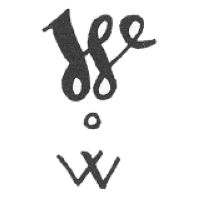
Image 011250-01/02-04
Used between 1764 and 1787.
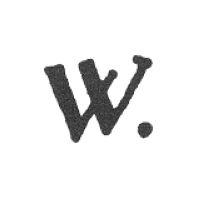
Image 011250-02-01
Used between 1772 and 1829.

Image 011250-02-02
Used between 1772 and 1829.
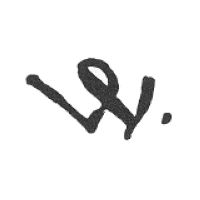
Image 011250-02-03
Used between 1772 and 1829.

Image 011250-02-04
Used between 1772 and 1829.
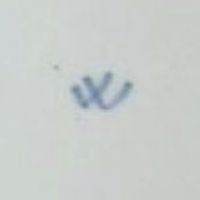
Image 011250-02/03-01
Used between 1787 and 1833.
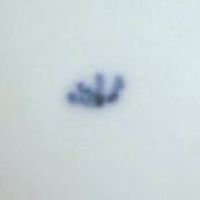
Image 011250-02/03-02
Used between 1787 and 1833.
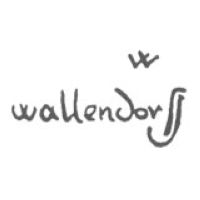
Image 011250-02/03-03
Used between 1787 and 1833.
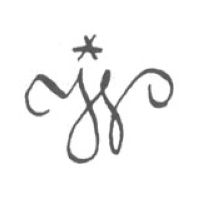
Image 011250-02/03-04
Used between 1787 and 1833.
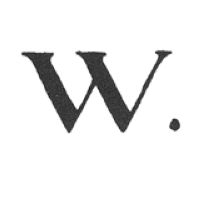
Image 011250-05-01
Used between 1887 and 1897.

Image 011250-05-02
Used between 1897 and 1915. Not an error, during this period the company really re-used an older mark.
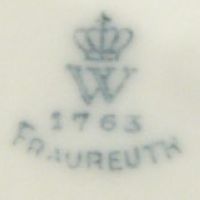
Image 011250-07-01
Used between 1919 and 1926, on items from old Fraureuth molds.
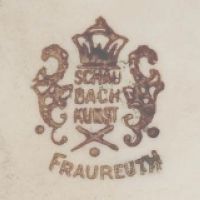
Image 011250-07-02
Used between 1926 and 1953, on items from old Fraureuth molds.
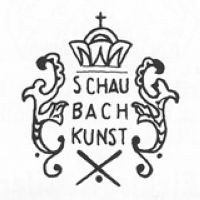
Image 011250-08-01
Used between 1926 and 1953.
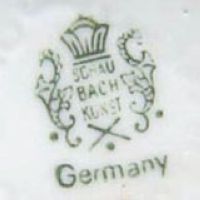
Image 011250-08-02
Used between 1926 and 1953.
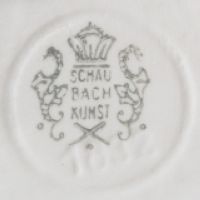
Image 011250-08-03
Used between 1926 and 1953.
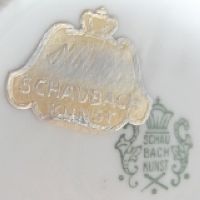
Image 011250-08-04
Used between 1926 and 1953, unicolor version together with golden 'Schaubach Kunst' label.
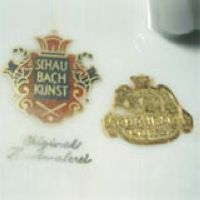
Image 011250-08-05
Used between 1926 and 1953, color version together with golden 'Schaubach Kunst' label.
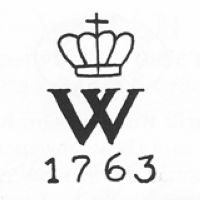
Image 011250-08-07
No exact date known. This version used by Schaubach was the prototype of the later used crowned-"W" mark.
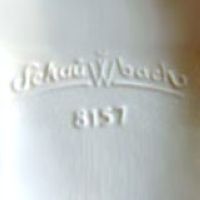
Image 011250-08-08
No exact date known, the Wallendorf crowned "W" integrated into the word "Schaubach".
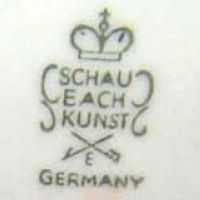
Image 011250-09-01
Used between 1953 and 1962. Note the bottom part: the crossed lines have the additional letters "VEB" attached.
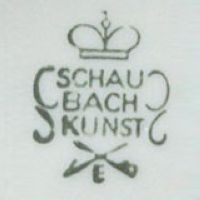
Image 011250-09-02
Used between 1953 and 1962, another example.
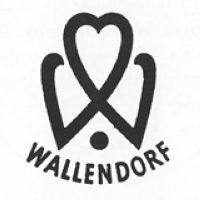
Image 011250-09-03
Used between 1958 and 1990.
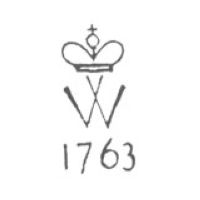
Image 011250-09-04
Used between 1958 and 1962, note the "1763".
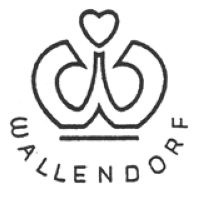
Image 011250-09-05
Used between 1959 and 1990.
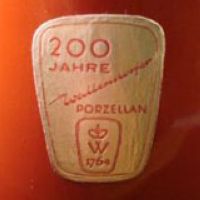
Image 011250-09-06
Used between 1963 and around 1965, anniversary sticker "200 Jahre Wallendorfer Porzellan" and crowned "W" above "1764".
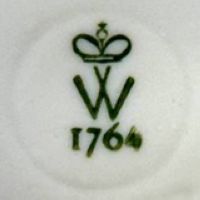
Image 011250-09-07
Used from 1963 onwards.
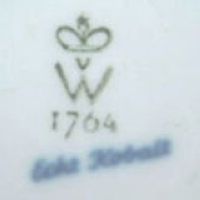
Image 011250-09-09
Used from 1963 onwards, with "Echt Kobalt".
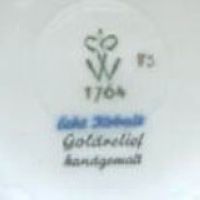
Image 011250-09-10
Used from 1963 onwards, with "Echt Kobalt", "Goldrelief" and "handgemalt".
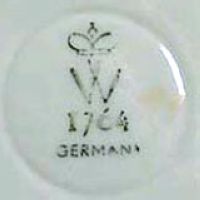
Image 011250-09-11
Used from 1963 onwards, note the "Germany".
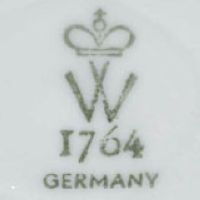
Image 011250-09-12
Used from 1963 onwards, note the "Germany".
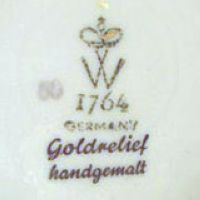
Image 011250-09-13
Used from 1963 onwards, here with "Germany", "Goldrelief" and "handgemalt".
(Picture: Wendy Kent)
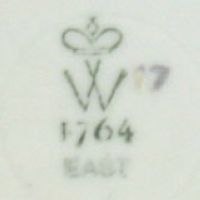
Image 011250-09-14
Used from 1963 onwards, early version here with a simple "East" addition completely without "Germany".
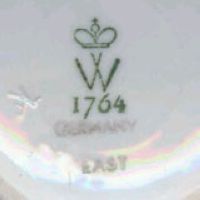
Image 011250-09-15
Used from 1963 onwards, early version with added "Germany East"
(Picture: Heather
& Andrew Eamer)
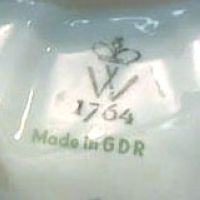
Image 011250-09-16
Used from 1963 onwards, with "Made in GDR".
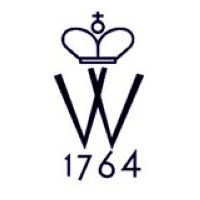
Image 011250-10-02
Company logo used around December 2006.
© 2004-2025 C.S.Marshall, all rights reserved